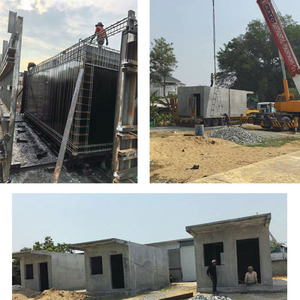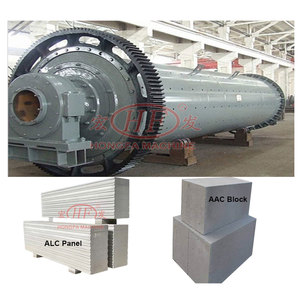
All categories
Featured selections
Trade Assurance
Buyer Central
Help Center
Get the app
Become a supplier

(6518 products available)








































Precast factory uses diverse materials that include concrete, steel reinforcement, and aluminum forms. Detailed information about these materials is as follows:
Concrete
Precast concrete is the primary material used in a precast factory. It is usually preferred due to its strength, durability, and versatility. More importantly, the concrete mix used in precast production is standardly designed to achieve specific properties such as high compressive strength and resistance to weather elements. They are also incorporated with additives like fly ash and slag to enhance workability and longevity.
Steel Reinforcement
Steel reinforcement bars, commonly known as rebar, play a pivotal role in maintaining the structural integrity of precast elements. Normally, steel is embedded in areas where tensile strength is needed. In addition, these reinforcements are carefully placed and secured within molds before the concrete is poured. This enables the concrete to withstand the forces once the precast elements are under loads.
Forms and Molds
Forms and molds act tremendously as the precast factory’s backbone. Usually, they are constructed from steel, aluminum, or fiberglass. More often than not, these materials are selected for their rigidity and ability to be reused for multiple production cycles. Moreover, steel forms offer high precision and durability. On the other hand, aluminum forms are lightweight and easy to maneuver. Standardly, this allows for quicker production processes in the factory.
Precast vs Cast In-Situ
While both precast and cast in-situ use concrete, they differ heavily in construction methodology and applications. To begin with, precast involves the creation of concrete elements in a controlled factory environment. Often, they are then transported in a concrete mixer and assembled on-site. In most cases, this approach enables faster construction. This is as a result of simultaneous work in the casting and on-site assembly. On the other hand, cast in-situ involves pouring concrete directly at the construction site. While this method allows for more flexibility in design, it commonly faces challenges related to weather conditions and on-site labor.
The uses of precast concrete factory include construction of residential buildings, commercial infrastructure, and bridges.
Precast Factory in Construction
A precast factory plays a big role in construction. They provide elements such as walls, slabs, and beams which speed up the building process. Normally, these precast products are manufactured in controlled settings, ensuring consistency and high quality. In addition, using precast materials minimizes the on-site labor and delays. While it increases efficiency, this approach also enables faster project completion.
Precast in Residential Buildings
The precast factories produce components that are commonly used in a variety of residential buildings, including high-rise apartments and single-family homes. Typically, precast concrete walls provide excellent insulation and durability. Thus enhancing the energy efficiency of the house. Moreover, precast stairs and floors are designed for quick installation and provide safety. Often, these elements are manufactured to meet specific design requirements. This enables architects to have flexibility in their designs.
Bridges and Transportation
The precast factory is very important in the construction of bridges and transportation systems. Usually, they manufacture pre-stressed beams and girders. These are key elements in the construction of highway overpasses and bridge structures. These precast components are favored due to their strength and ability to handle heavy loads. Also, they are constructed quickly with minimal disruption to the traffic. In addition, the use of precast elements improves the safety and reduce the construction timelines.
Wall Systems
Precast factories manufacture wall systems that are mostly utilized in commercial construction. Normally, these wall panels are designed with insulation for improved energy efficiency and sound attenuation. Additionally, precast wall systems provide rapid installation. They enable commercial buildings to be erected swiftly without compromising on quality. Habitually, these wall systems are designed to accommodate openings for windows and doors. Therefore making them ideal for diverse architectural designs.
Precast factory have a plethora of customization options. These options enable them to create highly specialized precast products. Below is the detailed information about these customization options:
Material Mixtures
Precast factory have the ability to adjust concrete mixtures based on the client’s specifications and project requirements. Usually, they include varying ratios of cement, aggregates, and water. This determines the strength and workability. In addition, by incorporating additives such as polymer fibers or silica fume, they are able to produce lightweight or high-performance concrete. Often, this adaptation allows for greater flexibility in meeting architectural and structural demands.
Precast Molds
The molds used in precast concrete are typically customized to achieve the desired shape and texture. Normally, these are crafted from steel, wood, or fiberglass. They allow for intricate designs and patterns on the finished product. More importantly, clients have the option to select surface finishes from smooth to exposed aggregate. This offers an extensive aesthetic appeal to the precast elements.
Sizes and Dimensions
These factories allow clients to stipulate the sizes and dimensions of their products. Usually, this customization is based on the specific needs of the construction project. It also ensures that the precast pieces fit seamlessly during installation. This is notably essential for large-scale projects. In these projects, precise measurements are mandatory for structural integrity.
Colors and Aesthetics
Clients can choose various colors for their precast concrete products. Standardly, this is to reflect their branding or design preferences. Moreover, precast concrete walls factories use pigmentation techniques to achieve a broad spectrum of hues. These include subtle earth tones to bold, vibrant shades. More importantly, this flexibility also extends to the texture of the surfaces. More often than not, it allows for customized engravings or form linings that replicate natural materials.
Reinforcement Options
This factory have diverse reinforcement choices. They include steel rebar, wire mesh, or fiber reinforcement. Often, the selection is based on the specific load-bearing requirements of the precast element. Besides, these adaptations enhance the durability and strength of the end product. Typically, it is ascertained that reinforced concrete performs well in a variety of settings.
When choosing a precast cement factory, business owners should take into account the functionality of the factory. They should pick precast factories that have numerous uses. Additionally, they should select precast factories that have strong, durable, and reliable concrete. In addition, they should choose precast factories that can be customized to suit unique concrete needs. Moreover, they should select precast factories that have a variety of sizes, weights, and shapes of the concrete. This is to ensure effective handling and transportation of the concrete. Below is a comprehensive list of the factors to consider.
When choosing precast concrete suppliers, it is pivotal for buyers to consider the material options used to make the concrete. For instance, reinforced concrete is usually stronger and safer, while precast light concrete is easier to install. Business owners should also look for precast factories that offer customized concrete. They should select factories that can offer a variety of precast concrete panel finishes such as wood, stone, or even stucco.
Business owners should request information about the workability and setting time of the concrete. They should opt for concrete that can easily be cut or drilled when required. More importantly, they should choose concrete with a relatively quick setting time. This will ensure quick project completion.
Buyers should choose precast factories that offer strong, durable, and reliable concrete. In particular, they should look for concrete that can withstand harsh weather conditions. Moreover, they should choose precast factories that can offer crack-free and stable concrete. This is especially important when the concrete is exposed.
Business owners should also consider acoustic and thermal properties. They should select precast concrete suppliers that offer excellent thermal insulation. This will ensure reduced energy costs. More importantly, they should choose acoustic concrete options. This will ensure effective sound insulation.
A precast concrete factory has numerous benefits. These benefits include high efficiency, minimized labor costs, and mass manufacturing capability.
High Efficiency
A precast concrete factory is efficient at producing the concrete quickly. Normally, they manufacture the concrete in controlled environments. This enables the team to focus on the quick assembly of the structures. Therefore, they do not have to worry about unfavorable weather conditions. More importantly, the ability to manufacture the concrete indoors means that the production can continue even when it is raining outside.
Cost-Effectiveness
Working with a precast concrete factory is cost-effective. Typically, the precast concrete is cheaper than pour-in-place alternatives. This is because the factory can group all the materials and processes together. More importantly, working with a precast concrete factory reduces the overall cost of the structure even though there will be a few transportation costs incurred.
Mass Manufacturing Capabilities
Precast concrete factories usually offer mass manufacturing capabilities. As a result, they can supply large construction projects with all the necessary concrete requirements. Therefore, if any construction project is planning to work on multiple floors or walls, the concrete factory is going to be able to provide enough material without delays. This will keep the building project on schedule.
Consistency and Quality
These factories are able to closely monitor their work. They ensure that every piece of the precast concrete is consistent in shape, texture, and strength. This will lead to high quality as well as well-performing buildings. In addition, consistent materials help prevent problems with delayed construction. Cracking or uneven floors rarely affect structures made using precast concrete.
Flexibility in Design
One of the main advantages of the precast concrete factory is that it can accommodate different designs. Depending on how the precast molds are made, they can provide many diverse finishes and shapes. This enables contractors to create architecturally appealing buildings without blowing the budget. Also, the precast concrete can be produced in customized shapes and sizes to meet unique project demands.
Yes. Precast factories are suitable for sustainable building projects. Normally, the precast concrete can include recycled materials. This will help reduce the overall environmental impact. Moreover, the factory's controlled processes usually ensure efficient use of resources. In addition, precast components are often designed for energy efficiency.
The lead time for customized products is normally affected by various factors. These factors include the complexity of the design, size, and current production schedules. Usually, lead times tend to range from a few weeks to several months. Consulting with the specific precast cement factory will provide precise timelines is advisable.
Business owners should consider flexibility for customization, factory experience, and material quality. Additionally, they should consider reliable and timely delivery of the concrete.
Working with precast concrete suppliers who operate factories offers numerous benefits. These benefits include high efficiency, cost effectiveness, mass manufacturing capabilities, consistency, and quality.